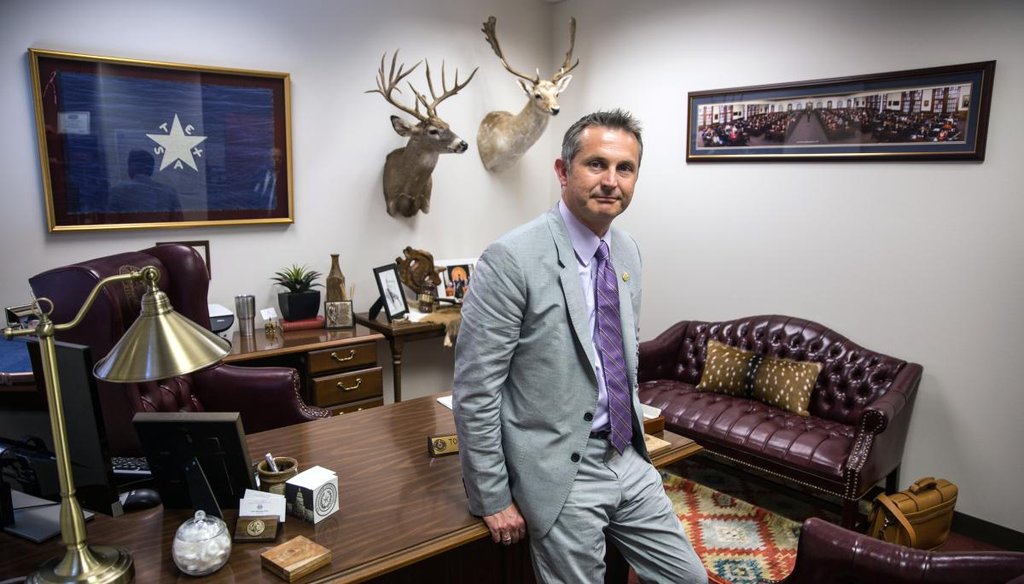Stand up for the facts!
Our only agenda is to publish the truth so you can be an informed participant in democracy.
We need your help.
I would like to contribute

Texas State Rep. Tom Oliverson said more people will die by suicide than the coronavirus this year, and that COVID-19 won't surpass the top 20 causes of death in Texas. (TAMIR KALIFA/ AMERICAN-STATESMAN)
Since the onset of the coronavirus pandemic in the United States, concerns about mental health care have grown, especially as the number of people living under stay-at-home orders has increased.
One Fort Worth television station reported that the Texas chapter of the National Alliance on Mental Illness has seen a 300% increase in calls to its helpline in March and April.
In a tweet sharing the article, CBSDFW wrote: "COVID-19 is not just causing harm to our physical health, it’s also leading to a major crisis in mental health."
Matt Rinaldi, a former Republican state representative from Irving, shared the post and added his own remark: "The Coronavirus RESPONSE is leading to a major crisis in mental health."
In reply, state Rep. Tom Oliverson, an anesthesiologist from Cypress, offered a claim about projected coronavirus deaths for 2020 compared with other causes of death.
"As it stands, suicide kills far more Texans annually than COVID-19," said Oliverson, a Republican. "So far, COVID-19 looks like it won’t crack the top 20 causes of death in Texas for 2020. Worth considering."
Given that projections of COVID-19 deaths are changing rapidly, due in part to shifting public policy in Texas, we opted not to put Oliverson’s statement on our Truth-O-Meter. But we can still look at the data, which show how current projections of COVID-19 deaths compare to the top causes of death in Texas.
Coronavirus deaths and projections
At the time of Oliverson’s statement, Texas was reporting 517 coronavirus deaths and different projections show the total number of deaths in the state is expected to at least double by August.
Eiman Siddiqui, Oliverson’s chief of staff, said the lawmaker used projections from the Institute for Health Metrics and Evaluation to make his statement, and shared a screenshot of the website that he said Oliverson took of his phone the day of his tweet.
As of April 21, when Oliverson tweeted this claim, the institute was projecting 957 coronavirus deaths by Aug. 4 in Texas. As of April 23, the number of projected deaths had increased to 1,241 by Aug. 4.
A different forecast from the University of Texas COVID-19 Modeling Consortium projects deaths by state and metro area three weeks into the future, using GPS data from cell phones to "quantify the changing impact of social-distancing measures" on flattening the curve.
The latest projection shows 1,488 cumulative deaths by May 21 in Texas (with a potential maximum of 2,414 deaths and a minimum of 1,113 deaths).
But Spencer Fox, a research associate at UT working on the model, said "the main caveat" in most projections is that they have been based on the assumption that the state will remain closed through the end of the year.
"If we continue to maintain social distancing and this shutdown state, then yes, this first wave will pass and mortality will be low," Fox said. "That was the whole point of putting those policies in place."
But different projection models for coronavirus deaths show that a second wave of the virus is possible if these measures change.
"Ninety-five to 99% of all the epidemiological models I’ve seen are suggesting that if today we went back to life as normal, we would see a second wave of the pandemic that would most likely — depending on how we reacted to it — be larger than this first wave," Fox said.
In the week following Oliverson’s statement, Gov. Greg Abbott allowed his statewide stay-at-home order to expire and he lifted restrictions to allow many businesses to reopen on Friday, at a reduced capacity.
Speaking before the Austin City Council the day after Abbott’s announcement loosening restrictions, Lauren Ancel Meyers, who leads UT’s modeling consortium, warned that relaxed policies restricting public activity will result in more coronavirus deaths.
Meyers outlined multiple scenarios for the council, one in which the Austin area remained under a stay-at-home order through September 2021, one in which the area was under more relaxed policies, like those Abbott enacted and one in which the relaxed policies were in place but isolation measures were reinstated as the number of COVID-19 cases started to increase.
Under the first scenario, Meyers said the city could reduce transmission of the virus by 90% and "would have probably kept total deaths under 200." As of April 27, there have been 48 COVID-19 related deaths in Austin, Round Rock and Georgetown, the area Meyers analyzed.
But if the state’s policies are relaxed, it "allows diseases to spread more widely," as transmission of the virus is reduced by 40% from the baseline, according to Meyers.
Referencing a line graph depicting a "second wave" of the virus under these relaxed policies, Meyers said: "the second wave is so large you don’t even see our first wave."
"That little blip to the left near April is what we’re experiencing right now and you can’t even see it because of what would happen, or what will happen in coming months if we let this thing transmit under semi-normal conditions," she said.
Under this scenario, there could be as many as 2,900 cumulative COVID-19 deaths in the Austin area alone — assuming the city or state do not reinstate isolation requirements at the onset of a wave of new cases.
If the city does reinstate isolation requirements at the sign of a spike in new cases, Meyers said the area could still see as many as 2,900 deaths.
"We don’t actually save more lives by doing this," she said. "We actually just prevent an excess — we prevent a catastrophic surge in hospitalization."
Meyers said all of these scenarios have a built in understanding that the most high-risk populations are being "cocooned" and their risk of transmission has been reduced by 95%.
But in a "pessimistic scenario" where these populations are not protected, Meyers said the Austin area alone could see as many as 6,500 deaths.
This uncertainty, highlighted here at the local level, makes it difficult to predict future coronavirus deaths this year with confidence.
Experts have cautioned against directly comparing the number of coronavirus deaths to other causes of death, as the virus poses a risk of exponential growth rates that most of the top causes of death in Texas do not.
They also pointed to the fact that the number of coronavirus deaths is dependent on mitigation efforts and public policies in a way that other causes of death, like heart disease, are not.
There is also the matter of timing. Looking nationally, COVID-19 has been the leading cause of death during certain weeks across the country, though it might not be a top cause of death on an annual basis.
Other causes of death
Oliverson said "far more" people die by suicide than COVID-19 in Texas, and it likely "won’t crack the top 20 causes of death" in the state this year.
In 2018, there were 3,930 suicide deaths in Texas, according to National Center for Health Statistics data.
The most recent available statewide data on other causes of death is from 2017, and can be analyzed two different ways: looking broadly at categories of fatalities (i.e., heart disease, cancer) or looking at more specific causes of death (i.e., heart attack, lung cancer).
Looking more broadly, there were 59,718 deaths in Texas from major cardiovascular diseases in 2017, the leading cause of death that year, followed by 40,609 deaths from malignant neoplasms, or cancerous tumors.
Toward the bottom of the top 20 broad causes of deaths in 2017, there were 957 deaths from "in situ neoplasms, benign neoplasms, and neoplasms of uncertain or unknown behavior" and 878 deaths from chromosomal abnormalities.
Looking at more detailed categories, there were 22,238 deaths from non-specific diseases, followed by 10,779 deaths from cerebrovascular disease, diseases affecting blood vessels in the brain, including strokes.
Toward the bottom of the top 20 more detailed causes of death in 2017, there were 2,813 deaths from pancreatic cancer and 2,758 deaths from "accidental poisoning and exposure to noxious substances."
Our Sources
Twitter, Tom Oliverson, April 21, 2020
CBS DFW, Coronavirus Pandemic-Related Loneliness Leads To 300% Increase In Calls To Mental Health Helpline, April 20, 2020
Email interview with Eiman Siddiqui, Oliverson’s chief of staff, April 22, 2020
Institute for Health Metrics and Evaluation, COVID-19, Texas, accessed April 23, 2020
American Foundation for Suicide Prevention, Suicide Facts & Figures: Texas 2019
PolitiFact, Understanding the scale of potential coronavirus deaths, April 3, 2020
Centers for Disease Control and Prevention, Stats of the State of Texas, accessed April 21, 2020
CDC, Suicide Mortality by State, 2018
CDC, Stress and Coping — Coronavirus Disease 2019, accessed April 22, 2020
CDC WONDER data, Underlying Cause of Death in Texas, 2018
Texas Department of State Health Services, Vital Statistics Annual Reports, accessed April 21, 2020
Business Insider, One chart shows how many Americans are dying from the coronavirus each week compared with other common causes of death like heart disease, cancer, and the flu, April 17, 2020
Stat News, It’s difficult to grasp the projected deaths from Covid-19. Here’s how they compare to other causes of death, April 9, 2020
New York Times, What 5 Coronavirus Models Say the Next Month Will Look Like, April 22, 2020
Reich Lab COVID-19 Forecast Hub, COVID-19 Forecasts, Cumulative Deaths Texas, April 21, 2020
City of Austin, April 28, 2020 Special City Council
Austin American-Statesman, Austin council considers future with thousands of coronavirus deaths, April 28, 2020
















































